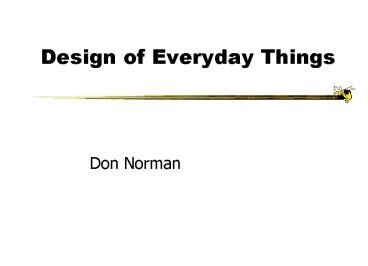Design of Everyday Things PowerPoint PPT Presentation
1 / 42
Title: Design of Everyday Things
1
Design of Everyday Things
- Don Norman
2
Agenda
- Discuss Normans views on HCI design
3
Summary
4
Don Norman
- Currently with Nielsen Norman group
- Previously Professor at UCSD, at Apple, HP, etc.
5
Discussion
- What did you take away from DOET book?
6
Daily Challenges
- How many of you can use all the functionality in
your - VCR
- Digital watch
- Copy machine
- Stereo system
- Plumbing fixtures
7
Fun Examples
- Leitz slide projector
- To move forward, short press
- To move backward, long press
- What happens when you get frustrated?
8
Fun Examples
Doors
One in this room!
9
Fun Examples
Phones
How do you - transfer a call - change volume -
store a number - ...
10
(No Transcript)
11
Changing Ringer Volume
- Press Program
- Press 6
- Set volume
- Low - Press 1
- Medium - Press 2
- High - Press 3
- Press Program
12
Important Concepts
- Affordances
- Visibility
- Conceptual models
- Mapping
- Feedback
- Constraints
13
Affordance
- What is it?
14
Visual Affordances
- Perceived and actual fundamental properties of an
object that determine how it could be used - Chair is for sitting
- Ball is for throwing
- Button is for pushing
15
Yikes!
16
Mantra
- Complex things may need explanation, but simple
things should not - If a simple thing requires instructions and
pictures, it is likely a failed design
17
Designing for People
- Normans 2 main principles
- Provide a good conceptual model
- Make things visible
18
Conceptual Model
- What does Norman mean by that?
19
Conceptual Models
- People build their own systems of how things work
- Example - car
- Designer can help user foster an appropriate
conceptual model - Appearance, instructions, behavior...
20
Visibility
- When functionality is hidden, problems in use
occur - Occurs when number of functions is greater than
number of controls - When capabilities are visible, it does not
require memory of how to use - Remind person how to use something
21
Simple Example
Electric plugs
What if both sides were big and you had
to remember which side the small one went into?
22
Simple Example
- Bathroom faucets
- Two functions
- Hot/cold
- Pressure
23
Bathroom Faucets 1
Can you figure out how to use it? Are two
functions clear and independent?
24
Bathroom Faucets 2
Can you figure out how to use it? Are two
functions clear and independent?
25
Bathroom Faucets 3
Can you figure out how to use it? Are two
functions clear and independent?
26
Two Important Principles
- Mapping
- Feedback
27
Mapping
- What does this mean?
28
Mapping
- Relationship between two objects, here, between
control and action/result - Good
- Car, various driving controls
- Mercedes Benz seat adjustment example
- Bad
- Car stereo - Knob for front/back speakers
29
Stove
Whichcontrolswhich?
30
Yikes!
31
Why Not Design Better
- Stove
- Speakers
Physical, monetary, convenience,
etc., constraints dictate otherwise
32
Feedback
- Let someone know what just occurred
- Can be sound thats made
- Can be change in physical state
33
Constraints
- Limitations on what can be done
- Physical - keys
- Semantic - menu graying
- Cultural - Colors
- Logical - When all above dont apply
34
Individual Differences
- Whom do you design for?
- Everyone? Impossible
- Average? Excluding half audience
- 95? Still may miss a lot
- Cant accommodate everyone
35
Individual Differences
- Designers are not representative of the user
population for whom they are designing - Dont expect users to think or act like you
- People vary in both physical attributes and
mental/cognitive attributes
36
Example
Scissors
Affordances - Insert something into
holes Constraints - Bigger hole for several
fingers, small for thumb Mapping - How to insert
fingers into holes suggested by
visible appearance Conceptual model - Suggested
by how parts fit together and move
37
Why Design is Hard
- Number of things to control has increased
dramatically - Displays are more virtual/artificial
- Marketplace pressure
- Adding operations cheaper (computers)
- Adding controls expensive (real estate, cost)
- Errors are becoming increasingly serious
38
Try and Try Again
- Norman thinks that it often takes 5 or 6 tries to
get something right - Simply may not have that luxury in a competitive
business environment
39
SHW 2 Return
- Grading thoughts
40
SHW 3 Bad Designs
- You get to be Don
- Find some bad design
- Describe it
- Articulate why theres a problem using his notions
41
Project
- P1 in today
- Grading may take a little while
- P2 out today
- Its all about design
- Multiple alternatives
- Dont do divide-and-conquer
- Dont start implementing
- Poster session near end of this part
42
Upcoming
- Design (general)
- Design exercise in class
- Graphic design

